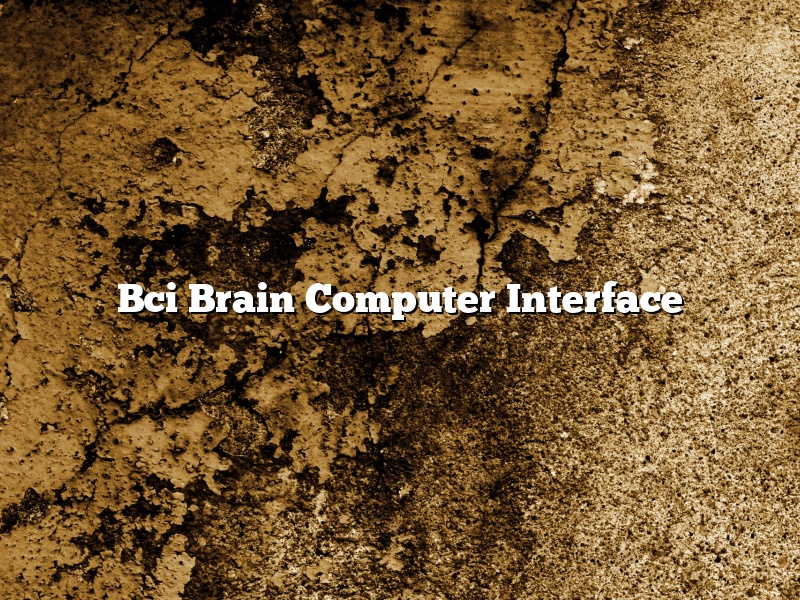What is BCI?
BCI is a technology that enables a communication pathway between the human brain and external devices. This technology has the potential to improve the quality of life for people with disabilities and conditions such as paralysis, by providing a way for them to interact with the world using only their thoughts.
How does BCI work?
The BCI process begins with the user performing a mental task, such as focusing on a specific word or image. This task produces a unique brain signal that can be detected and monitored using special equipment. This signal is then used to control an external device, such as a computer or wheelchair.
What are the benefits of BCI?
BCI offers a number of potential benefits for people with disabilities, including:
• Independence: BCI can provide people with disabilities with a level of independence that they may not otherwise have.
• Communication: BCI can provide a means of communication for people who are unable to speak.
• Quality of Life: BCI can improve the quality of life for people with disabilities by giving them greater independence and the ability to communicate with others.
Are there any risks associated with BCI?
There are some risks associated with BCI, including:
• Electrical shock: If the equipment used to detect and monitor brain signals is not properly calibrated, it may send electrical shocks to the user.
• Infection: The electrodes used to detect brain signals may introduce bacteria into the user’s body.
• False signals: Brain signals can be easily misinterpreted, which may lead to incorrect commands being sent to the external device.
How is BCI being used currently?
BCI is currently being used to control a variety of external devices, including:
• Computers: BCI can be used to control a computer, allowing the user to type, navigate the web and perform other tasks.
• Wheelchairs: BCI can be used to control a wheelchair, allowing the user to move around independently.
• Home appliances: BCI can be used to control home appliances, such as lights and fans.
Is BCI available to the general public?
At this time, BCI is not available to the general public. It is primarily being used as a research tool to help people with disabilities. However, there is potential for BCI to be used more widely in the future.
Contents [hide]
What is brain-computer interface used for?
What is a brain-computer interface?
A brain-computer interface, or BCI, is a technology that allows a person to control a computer or other electronic device using only their thoughts. BCIs are sometimes also called “mind-reading” devices, as they allow people to communicate with others without speaking or typing.
How does a brain-computer interface work?
A brain-computer interface works by reading the electrical signals produced by the brain. These signals are picked up by electrodes that are placed on the scalp. The electrodes convert the signals into digital information that can be read by a computer.
What are some common uses for brain-computer interfaces?
There are a number of different applications for brain-computer interfaces. Some common uses include:
– Communication: BCIs can be used to allow people with disabilities to communicate with others.
– Control of electronic devices: BCIs can be used to control devices such as computers, wheelchairs, and prosthetic limbs.
– Control of medical devices: BCIs can be used to control medical devices such as pacemakers and insulin pumps.
– Treatment of conditions such as epilepsy and Parkinson’s disease: BCIs can be used to help treat conditions by monitoring and adjusting the brain’s electrical activity.
– Research: BCIs are used in research to help unlock the mysteries of the brain.
Is brain-computer interface possible?
Brain computer interface (BCI) technology is still in its early developmental stages, but there is hope that it could eventually become a common way to interact with electronic devices. So far, BCI technology has been used to allow people with disabilities to control computers or other devices with their thoughts.
There are different ways to create a BCI. One common approach is to use electroencephalography (EEG) to measure brain activity. This can be done by placing electrodes on the scalp to measure the electrical signals that are produced when neurons fire. These signals can then be translated into commands that can be used to control devices.
Another approach is to use near-infrared spectroscopy (NIRS) to measure brain activity. This approach involves shining light on the scalp and measuring the amount of light that is absorbed. This can be used to measure the amount of oxygenated hemoglobin in the brain. This can be used to determine which areas of the brain are active, and this information can be used to create a BCI.
So far, BCI technology has been used to allow people with disabilities to control devices. For example, people with spinal cord injuries may be able to use BCI technology to control a wheelchair. BCI technology has also been used to allow people with cerebral palsy to communicate.
There is hope that BCI technology could eventually be used to allow people to control devices with their thoughts. For example, people could use BCI technology to control a computer, a car, or even a prosthetic limb. There is also hope that BCI technology could be used to help people with disabilities communicate or to help them regain movement.
However, there are still some challenges that need to be addressed before BCI technology can be widely used. One challenge is that the technology needs to be more reliable and accurate. Another challenge is that the equipment needs to be more portable and affordable.
Despite these challenges, there is hope that BCI technology will eventually become a common way to interact with electronic devices.
How much does a brain-computer interface cost?
A brain-computer interface, or BCI, is a device that allows a person to control a computer or other electronic device using only their thoughts. The cost of a BCI varies depending on the type and features of the device.
Some basic, low-cost BCIs that allow a person to move a cursor on a screen or open and close a hand-held device can be purchased for as little as $50. More sophisticated BCIs that allow a person to control a computer or wheelchair using thoughts alone can cost up to $10,000.
Most BCIs use electrodes to read brain signals. The electrodes are placed on the scalp or inside the brain. The cost of the electrodes and the other equipment needed to read brain signals can add several thousand dollars to the cost of a BCI.
Some BCIs also require surgery to implant the electrodes in the brain. The cost of surgery can add several thousand dollars to the cost of a BCI.
There is also a ongoing cost associated with using a BCI. The cost of replacement electrodes, software updates, and other related expenses can be several hundred dollars per year.
Overall, the cost of a BCI can range from a few hundred dollars to tens of thousands of dollars, depending on the type and features of the device.
Which technology is used in brain-computer interface?
Brain-computer interface technology is still in its early developmental stages, but there is a lot of potential for this technology to improve the quality of life for people with disabilities. Currently, the most common type of brain-computer interface uses electroencephalography (EEG) to read electrical activity in the brain. This technology can be used to control devices such as prosthetic limbs, wheelchairs, and computers.
Some newer brain-computer interface technologies use near-infrared spectroscopy (NIRS) to measure brain activity. NIRS is a non-invasive technology that uses light to measure blood flow and oxygenation in the brain. This technology may be able to provide more accurate readings than EEG, and it is less sensitive to movement and electrical noise.
Another potential technology for brain-computer interfaces is functional near-infrared spectroscopy (fNIRS). This technology uses light to measure blood flow and oxygenation in the brain. fNIRS is less sensitive to movement and electrical noise than NIRS, and it can be used to measure brain activity at a much higher resolution than EEG.
Brain-computer interfaces have the potential to improve the quality of life for people with disabilities, and the technology is constantly evolving. It will be interesting to see what the future of brain-computer interfaces holds.
What problems can BCI solve?
Brain-computer interfaces, or BCIs, are devices that allow people to control computers or other devices with their thoughts. BCIs can be used to control prosthetic devices, wheelchairs, and other assistive technology. They can also be used to improve communication for people with speech or communication disorders, or to help people with neurological disorders such as cerebral palsy, multiple sclerosis, or cerebral stroke.
BCIs can also be used to improve cognitive function. For example, they can be used to help people with Attention Deficit Hyperactivity Disorder (ADHD) to focus on tasks, or to help people with traumatic brain injuries to improve their memory. BCIs can also be used to help people with anxiety or depression to regulate their emotions.
BCIs are a relatively new technology, and there are still some limitations to their use. For example, BCIs can be expensive, and they may not be suitable for people with certain medical conditions. However, BCIs have the potential to help people with a wide range of disabilities, and research on BCIs is ongoing.
Is BCI the future?
Is BCI the future?
There is no doubt that BCI technology is rapidly evolving and has a lot of potential applications. So the question is, is BCI the future?
There are a number of potential applications for BCI technology, including:
-Healthcare: BCI technology can be used to help people with disabilities or injuries to regain movement and control.
-Education: BCI technology can be used to help people learn and improve cognitive skills.
-Gaming and Entertainment: BCI technology can be used to create new and more immersive gaming experiences.
-Industry: BCI technology can be used to improve productivity and efficiency in a number of industries.
-Military: BCI technology can be used for security and defence purposes.
There are undoubtedly a lot of potential applications for BCI technology and it seems likely that it will play an increasingly important role in the future. However, it is still early days and there are some challenges that need to be addressed before BCI can be widely adopted. For example, the cost of BCI technology is still quite high and there is a lack of standards and protocols. But as the technology continues to evolve, it is likely that these issues will be addressed and BCI will become more widely used.
Who invented BCI?
Who invented BCI? BCI, or Brain-Computer Interface, is a technology that allows people to control devices with their thoughts. It was invented by Dr. Gerwin Schalk in the early 2000s.
Brain-Computer Interface technology has come a long way in the past few years. It is now possible for people with spinal cord injuries to control a computer with their thoughts. BCI is also being used to help people with conditions like ALS and cerebral palsy communicate with others.
Dr. Gerwin Schalk is the man who invented BCI. He first started working on the technology in the early 2000s. Schalk is a computer scientist who is based at the Albany Medical Center in New York.
Brain-Computer Interface technology is still in its early stages, but it has the potential to change the lives of millions of people. Researchers are working on ways to improve BCI and make it more accessible to people with disabilities.




